Let’s just cut to the chase. HACKSAW RIDGE is the BEST PICTURE OF THE YEAR!
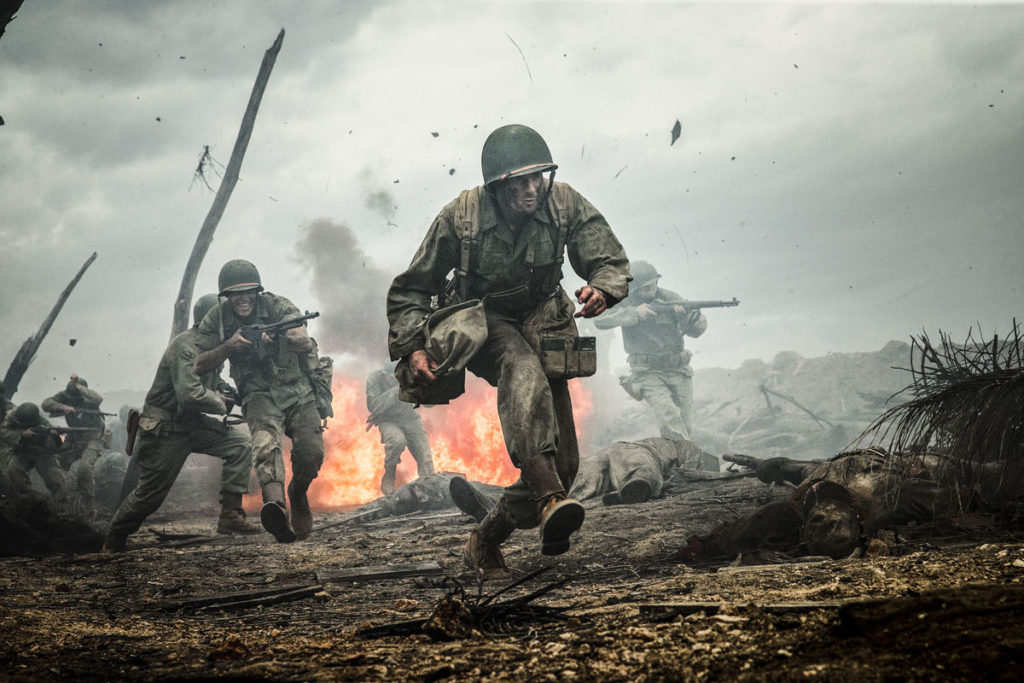
It’s been ten years since Mel Gibson stepped behind the camera, but if that absence means he reappears with something as glorious as HACKSAW RIDGE, then I say, enjoy the next decade, Mel. We’ll see you in another ten years because HACKSAW RIDGE is masterful filmmaking.

Written by Andrew Knight and Robert Schenkkan, this is the true story of Seventh-day Adventist and Army medic Desmond T. Doss, the first conscientious objector in the history of the United States to be awarded the Congressional Medal of Honor. Making Doss’ story even more incredible is that beyond his commitment to his beliefs and never carrying any sort of weapon, i.e., gun, knife, grenade, etc., he single-handedly saved the lives of 75 men under heavy fire by the Japanese atop HACKSAW RIDGE, the bloodiest battle in the Pacific Theatre during World War II, after the rest of the rifle company, 1st Battalion, 307th Infantry of the 77th Infantry Division had pulled out. Although two conscientious objectors have subsequently been awarded the Congressional Medal, Doss’ bravery and heroism are unparalleled in the annals of our country. (Desmond T. Doss died March 23, 2006.)

Story structure is straightforward and classic in its design and construct. Tapping into themes of religion, honor, duty, family, brotherhood, hatred, forgiveness and love, all are intertwined and go far in showing that all can successfully co-exist. A tacit commentary on the world today. Written in broader strokes during Doss’ days as a youth in Lynchburg, West Virginia, Knight and Schenkkan give us all the particulars needed to understand the man who Desmond Doss would become once he enlisted in the Army. We meet his alcoholic and abusive father Tom, himself suffering from what we now recognize as PTSD, following his military service in World War I in France. Doss’ mother Bertha is a kind, loving and protective woman who was often victim to her husband’s violent outbursts, but her stoicism and strength played a large part in shaping Desmond. Thanks to Mel Gibson’s expertise, childhood adventures of Desmond and his brother give us visual reference for what is to come on Okinawa, not to mention the bullying and taunting Desmond endures as a youth, prescient of what would face him boot camp. And of course, the love of Desmond’s life, Dorothy Schutte is the driving force that would carry his heart through the war and home to her.

But once Desmond arrives in boot camp and is ultimately deployed to Okinawa and HACKSAW RIDGE (an escarpment 400+ feet high on Okinawa which requires scaling the rock face on ropes to reach the top), Gibson and company soar.
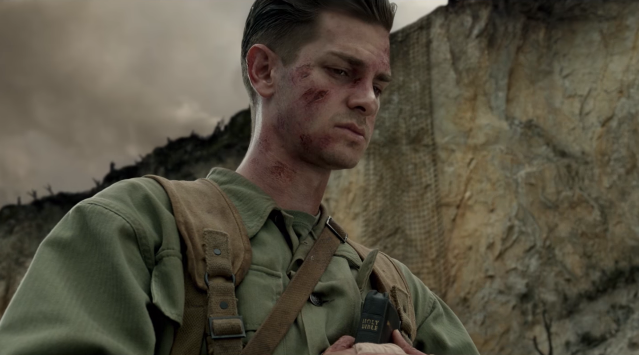
On his arrival at camp, Desmond is immediately met with hostility, from not only his brothers-in-arms, but his commanding officer Sergeant Howell. Things only get worse for Desmond when he refuses to pick up a rifle, invoking his right as a conscientious objector. It was always Desmond’s intent to serve as a medic, saving lives, not taking them. As tension mounts among the unit, Desmond’s strength of character takes on greater shape and deeper meaning while he suffers physical abuse, solitary confinement and Army trials.

Once on Okinawa, HACKSAW RIDGE explodes, literally and figuratively, as almost immediately Gibson treats us to some of the bloodiest and most action-packed, nail-biting, heart-stopping imagery ever seen on film as the 77th faces off with a never-ending onslaught by the Japanese. For almost 30-minutes, Gibson places us in the moment, in the battle. We are right next to these men we have come to know as bullets pierce their helmets, bodies are severed, entrails ripped from them by Japanese bayonets. Battle is relentless. And through it all, there is also Desmond Doss, scrambling under and through mortar fire and the steel rain of bullets, grabbing every injured man he can and pulling them to safety. From the first image of Doss throwing himself atop a Japanese soldier and tackling him to the ground in order to save one of his company, the tables turn. It is that selflessness that endears him to his brethren as where they once viewed him as a coward, they now do their utmost to protect him. The level of emotion is so high, the performances so strong, chills fill you just watching this unfold. There is a visceral intensity, both visually and emotionally that is riveting.
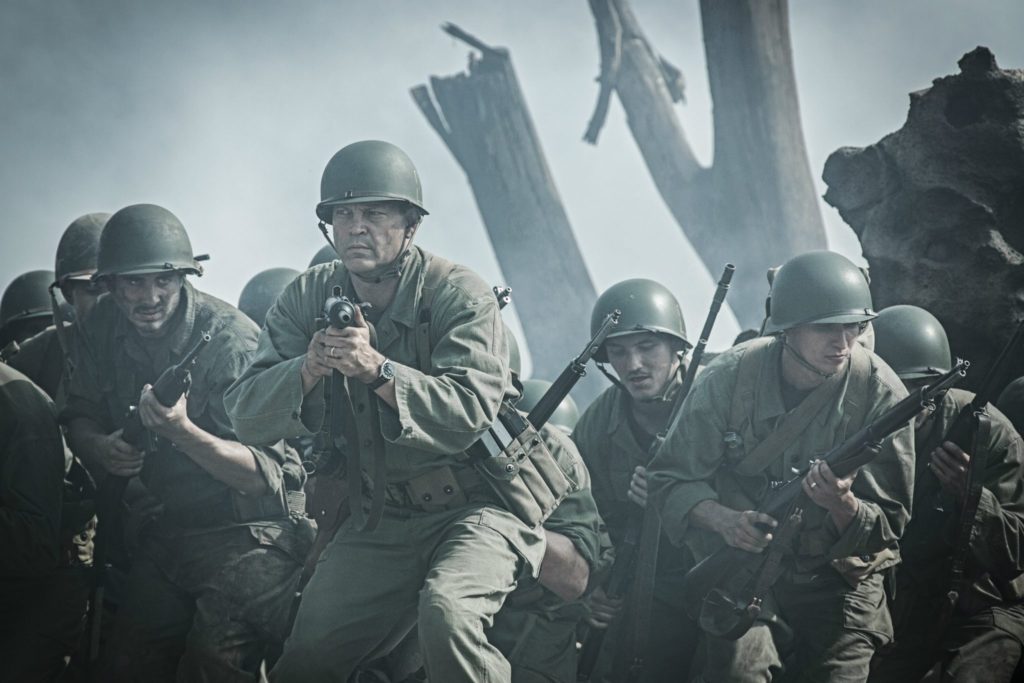
As day turns into night and into day and into night and with casualties mounting, the 77th are unable to take the ridge. They pull out. But unbeknownst to all is that Desmond Doss is still atop HACKSAW RIDGE. As the order came to retreat, he saw and heard a man call for help. Doss would not leave him. And one man led to another and another and another. It was Desmond Doss’ calling to keep saving “just one more”. Recalling memories of his youth and his own ingenuity designing a series of double bowline knots he used to use as in his boyish adventures in Lynchburg, Doss figured out how to create a litter to lower each man, one by one, to the safety of the shore below. It took longer for the Brass to figure out that divine intervention had come for the 77th in the form of Desmond Doss.

Notable is that Gibson, Knight and Schenkkan stick close to history and Desmond Doss’ story, calling on interviews with survivors, descendants and old film footage to commit to authenticity. A story already larger than life doesn’t need cinematic embellishment. While some of the characters are composites of several men, such as Luke Bracey’s Captain Smitty Ryker, others like Doss, Dorothy, Tom and Bertha Doss, and Sam Worthington’s Captain Glover are real individuals. Although there are some small liberties taken for the screen (e.g., Doss enlists in the film as opposed to being drafted in real life), HACKSAW RIDGE stays true to not only Doss’ story but who Desmond Doss was as a man.
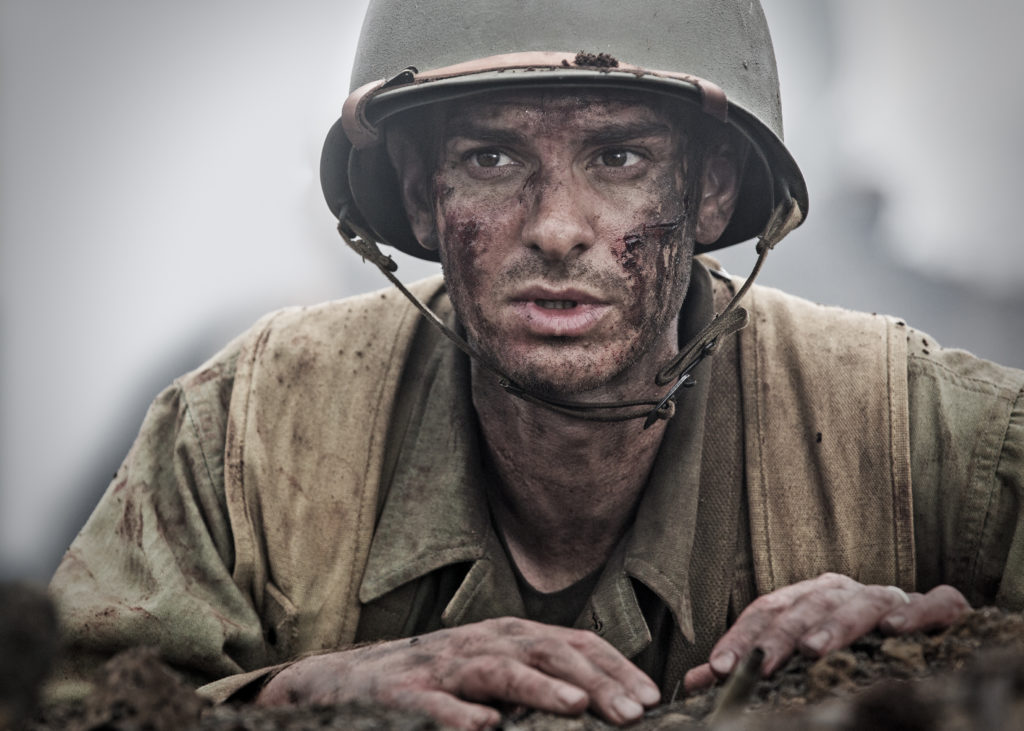
Don’t be surprised to hear Andrew Garfield’s name announced come Oscar nominations morning in January. As Desmond Doss, Garfield is beyond outstanding. With conviction and confidence, Garfield bares his heart and soul with this performance. His intensity is contagious and puts you on the edge of your seat, clutching the theatre chair and your heart in the film’s climactic third act as in character, Doss begs God to help him “save just one more.” Powerful powerful performance, but then Garfield laces that with sensitivity and “aw shucks” lightness that makes not only the character of Desmond Doss, but Garfield himself, more endearing. Striking are scenes where Doss’ religious beliefs continually shape the man he is. A hush falls over one watching Garfield in character reciting Bible passages and carrying his Bible close to his heart. Again, a testament to the filmmakers with attention to this well-documented minutiae from Doss’ life.
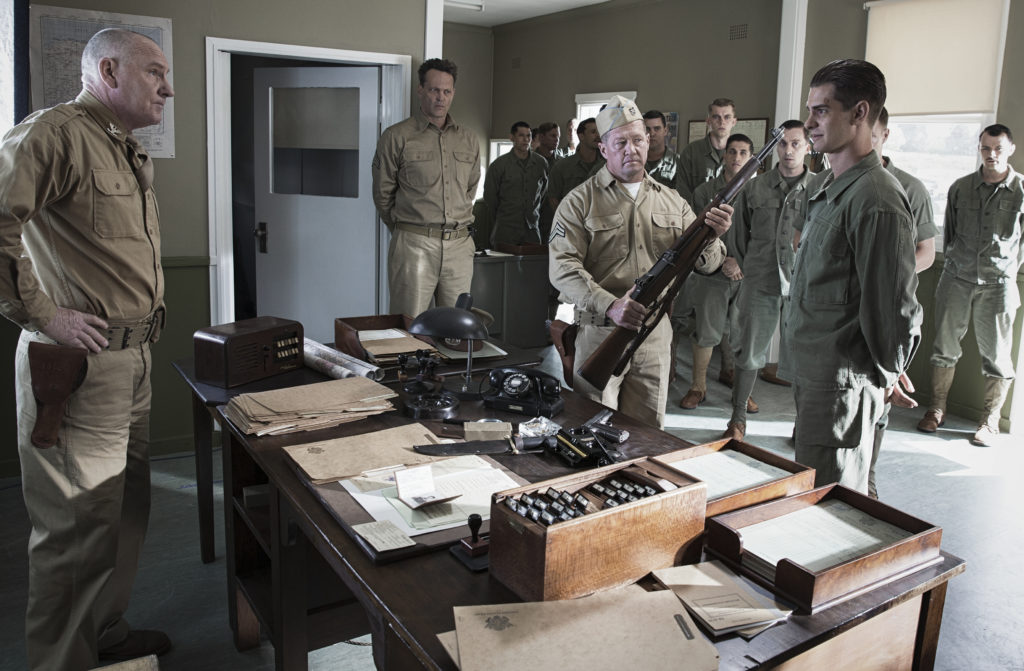
Not typically a fan of Vince Vaughn, although respectful of his work, this portrayal of Sergeant Howell is the performance of his career, worthy of being bandied about for a supporting actor nomination. Sam Worthington is solid as Captain Glover and gets the chance to show an emotional shift we don’t normally get to see.
As Smitty, Luke Bracey knocks it out of the park with his cocky New “Yawker” take on the character. Bracey just gets better and better in his work – and in his choice of roles – and here gets a chance to flex his acting muscles. While he fell short on emotional range in “Point Break” after exhibiting leading man quality in “The Best of Me”, he ups the ante in HACKSAW RIDGE, capitalizing on the physicality we have seen from him in “The November Man” and “Point Break”, while delivering layered emotion with nuance thanks to facial expressiveness and subtlety.

Rachel Griffiths and Hugo Weaving are solid as Bertha and Tom Doss, with Weaving truly taking us on a roller coaster ride as Tom puts aside his hatred of war and embraces it in order to help his son. Beautifully lensed and edited with quiet pacing, Weaving sets the tone for the ideas of “self-sacrifice” and “the greater good.”; something we then see Garfield’s Desmond take to a level that truly must have been driven by a higher power. Again, kudos to scribes Knight and Schenkkan with their story structure and thematics, and to Gibson for superb visual metaphor that furthers the themes.

Interesting is that while HACKSAW RIDGE is a “war” movie, Gibson and company spend more time showing us the humanity that rises above the horrors. This succeeds because of the authenticity and depth of each of the characters. Even the smallest character among the men in Desmond’s unit is distinctive and defined as a person, be it just through Vince Vaughn’s amazing opening monologue as Sgt. Howell insulting each of the soldiers in the barracks, or from short interactions between the men themselves.
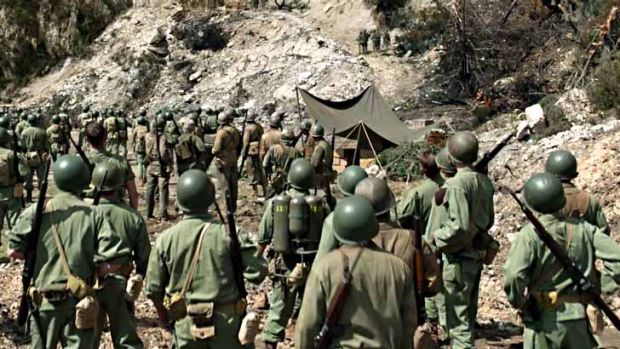
Simon Duggan’s cinematography is nothing short of dazzling, particularly during battle sequences. Quite honestly, these may be some of the best battle images on film. The battle sequences – and also kudos to Second Unit Director Mic Rodgers – are visually stunning with the use of light and shadow and color. Hand held work is exemplary, and seamlessly melds with the minimal use of CGI. But then look at the simplicity and beauty of the light and the lightness of Desmond’s home and the woods. Interesting are the number of shots that take us into the sky, metaphorically reaching to heaven. The spirituality and beliefs of Desmond Doss are carried through on every level, but become celebratory in the visuals. And just check out those camera angles as men climb up and down HACKSAW RIDGE!
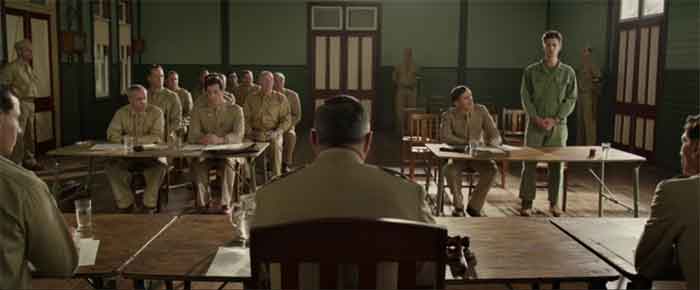
Sound design/editing/mixing led by Rob Mackenzie and Kevin O’Connell is flawless. The precision and detail of specific sounds is nothing short of an auditory wonder. From individual gun and bullet piercing sounds to leaves wafting in the breeze or young boys stomping on top of rocks or the sound of a brick hitting a head or the quiet at a somber dinner table – every sound is distinguishable and adds something to every scene. But then they add moments of silence amidst the fury of battle, shocking, dynamic and effective as we hear only the dying breath of a man or momentary whiz of a bullet bringing us back to the reality of war. Striking, effective. Oscar-worthy. Dialogue is never sacrificed; score never overpowers the dialogue, foley and other sound movements. A truly effective sonic experience.

John Gilbert’s editing is some of the best ever on film, particularly when it comes to the action battle sequences. We are in the moment, immersed in battle with the men. The pulse races and the heart pounds, exponentially increasing as the battle progressed, but more importantly, during the quiet, waiting for the other shoe to drop and for more Japanese to appear; and when they do, we are so on edge, the tension is so tight it’s as if a theatre of collective rubber-bands are snapping. Brilliant.
Completing the sensory and emotional experience is the score by Rupert Gregson-Williams.

And a very strong caveat for you: Stay through the credits. Included are interviews with Desmond Doss and others, as well as photographic imagery of the men of the 77th. Have the tissues ready.
Cinematic from start to finish. Epic! Sweeping! Heart-stopping! Heart-pounding! Mel Gibson hasn’t lost his touch. He knows how to tell a story, make a movie and make is superbly. A true masterpiece. HACKSAW RIDGE is the Best Picture of the Year!
Directed by Mel Gibson
Written by Andrew Knight and Robert Schenkkan
Cast: Andrew Garfield, Luke Bracey, Vince Vaughn, Sam Worthington, Teresa Palmer, Hugo Weaving, Rachel Griffiths












